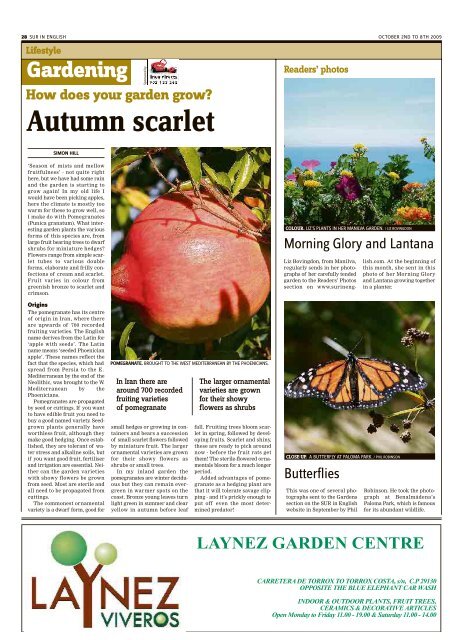Stepping out for grey power - Carvajal Spain
Stepping out for grey power - Carvajal Spain
Stepping out for grey power - Carvajal Spain
You also want an ePaper? Increase the reach of your titles
YUMPU automatically turns print PDFs into web optimized ePapers that Google loves.
28 SUR IN ENGLISH OCTOBER 2ND TO 8TH 2009<br />
Lifestyle<br />
Gardening<br />
Howdoesyourgardengrow?<br />
Autumn scarlet<br />
SIMON HILL<br />
‘Season of mists and mellow<br />
fruitfulness’ - not quite right<br />
here, but we have had some rain<br />
and the garden is starting to<br />
grow again! In my old life I<br />
would have been picking apples,<br />
here the climate is mostly too<br />
warm <strong>for</strong> these to grow well, so<br />
I make do with Pomegranates<br />
(Punica granatum). What interesting<br />
garden plants the various<br />
<strong>for</strong>ms of this species are, from<br />
large fruit bearing trees to dwarf<br />
shrubs <strong>for</strong> miniature hedges?<br />
Flowers range from simple scarlet<br />
tubes to various double<br />
<strong>for</strong>ms, elaborate and frilly confections<br />
of cream and scarlet.<br />
Fruit varies in colour from<br />
greenish bronze to scarlet and<br />
crimson.<br />
Origins<br />
The pomegranate has its centre<br />
of origin in Iran, where there<br />
are upwards of 700 recorded<br />
fruiting varieties. The English<br />
name derives from the Latin <strong>for</strong><br />
‘apple with seeds’. The Latin<br />
name means ‘seeded Phoenician<br />
apple’. These names reflect the<br />
fact that the species, which had<br />
spread from Persia to the E.<br />
Mediterranean by the end of the<br />
Neolithic, was brought to the W.<br />
Mediterranean by the<br />
Phoenicians.<br />
Pomegranates are propagated<br />
by seed or cuttings. If you want<br />
to have edible fruit you need to<br />
buy a good named variety. Seedgrown<br />
plants generally have<br />
worthless fruit, although they<br />
make good hedging. Once established,<br />
they are tolerant of water<br />
stress and alkaline soils, but<br />
if you want good fruit, fertiliser<br />
and irrigation are essential. Neither<br />
can the garden varieties<br />
with showy flowers be grown<br />
from seed. Most are sterile and<br />
all need to be propagated from<br />
cuttings.<br />
The commonest ornamental<br />
variety is a dwarf <strong>for</strong>m, good <strong>for</strong><br />
Sponsored by<br />
POMEGRANATE. BROUGHT TO THE WEST MEDITERRANEAN BY THE PHOENICIANS.<br />
In Iran there are<br />
around 700 recorded<br />
fruiting varieties<br />
of pomegranate<br />
small hedges or growing in containers<br />
and bears a succession<br />
of small scarlet flowers followed<br />
by miniature fruit. The larger<br />
ornamental varieties are grown<br />
<strong>for</strong> their showy flowers as<br />
shrubs or small trees.<br />
In my inland garden the<br />
pomegranates are winter deciduous<br />
but they can remain evergreen<br />
in warmer spots on the<br />
coast. Bronze young leaves turn<br />
light green in summer and clear<br />
yellow in autumn be<strong>for</strong>e leaf<br />
The larger ornamental<br />
varieties are grown<br />
<strong>for</strong> their showy<br />
flowers as shrubs<br />
fall. Fruiting trees bloom scarlet<br />
in spring, followed by developing<br />
fruits. Scarlet and shiny,<br />
these are ready to pick around<br />
now - be<strong>for</strong>e the fruit rats get<br />
them! The sterile-flowered ornamentals<br />
bloom <strong>for</strong> a much longer<br />
period.<br />
Added advantages of pomegranate<br />
as a hedging plant are<br />
that it will tolerate savage clipping<br />
- and it’s prickly enough to<br />
put off even the most determined<br />
predator!<br />
Readers’ photos<br />
COLOUR. LIZ’S PLANTS IN HER MANILVA GARDEN. / LIZ BOVINGDON<br />
Morning Glory and Lantana<br />
Liz Bovingdon, from Manilva,<br />
regularly sends in her photographs<br />
of her carefully tended<br />
garden to the Readers’ Photos<br />
section on www.surineng-<br />
CLOSE-UP. A BUTTERFLY AT PALOMA PARK. / PHIL ROBINSON<br />
Butterflies<br />
This was one of several photographs<br />
sent to the Gardens<br />
section on the SUR in English<br />
website in September by Phil<br />
lish.com. At the beginning of<br />
this month, she sent in this<br />
photo of her Morning Glory<br />
and Lantana growing together<br />
in a planter.<br />
Robinson. He took the photograph<br />
at Benalmádena’s<br />
Paloma Park, which is famous<br />
<strong>for</strong> its abundant wildlife.


